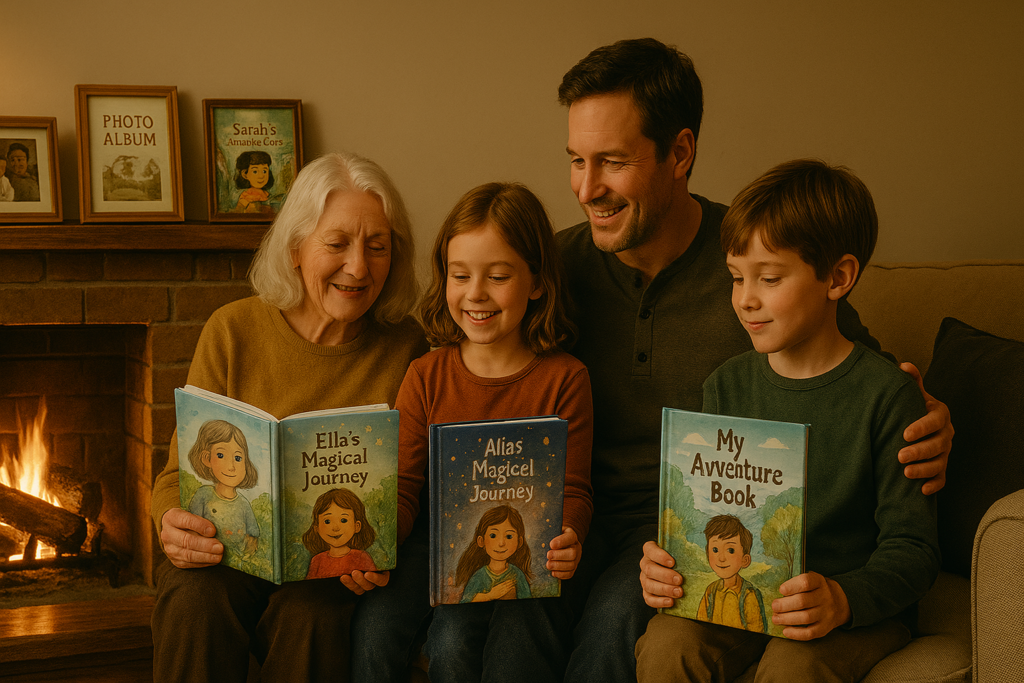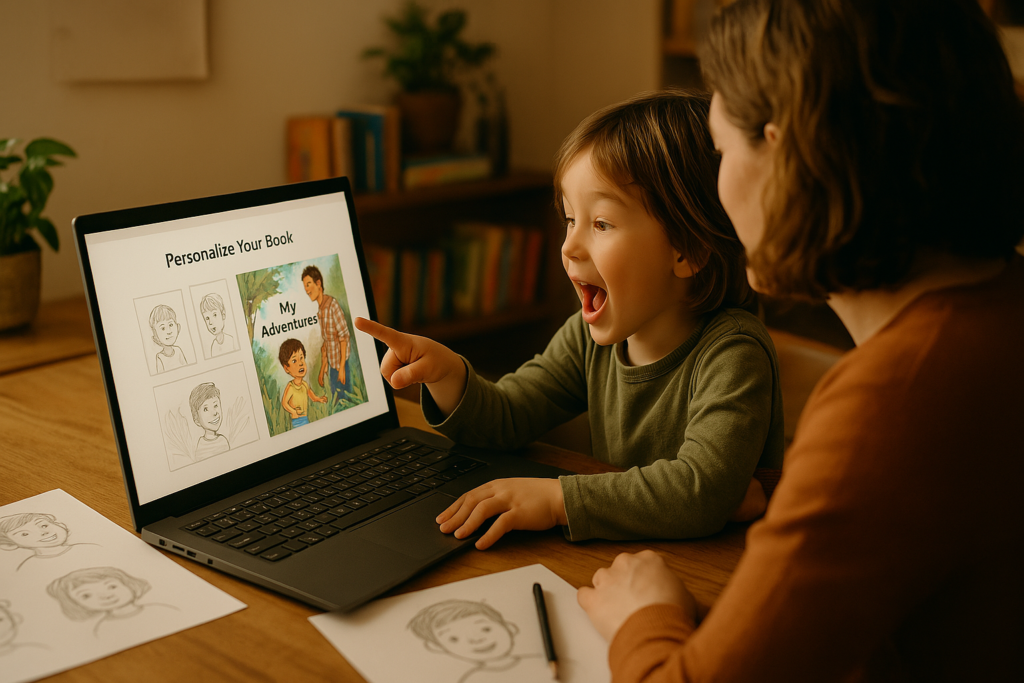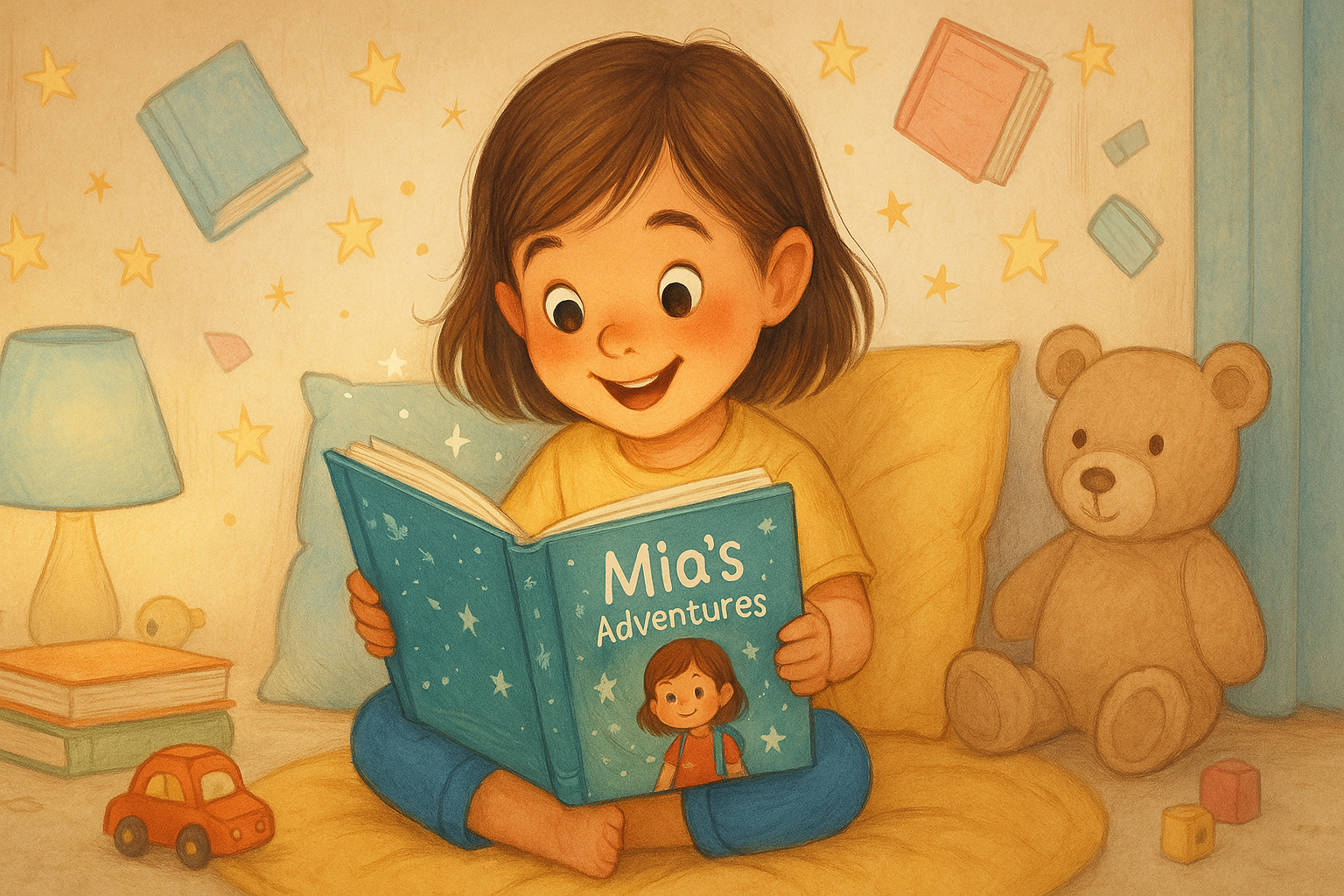Young readers connect with children’s book illustrations more deeply than words alone. Every children’s book needs pictures. These visual elements grab a child’s attention and create lasting memories in their developing minds. The styles range from cartoon characters to realistic scenes.
Children’s book illustrations appear everywhere, not just in picture books. Today’s most popular approach remains the cartoon style. Professional illustrators mostly use digital painting as their creation method. Artists dedicate years to becoming skilled in their unique children’s book illustration styles. Their work produces children’s book art ranging from wondrous and abstract to bold, bright, muted, and subdued. Each style matches different types of stories perfectly. Its variety means you have plenty of options to think over when picking custom-illustrated books as gifts.
Why Custom Illustrated Books Make Great Gifts

Custom-illustrated books are much more than simple gifts. They create a customized experience that builds deep connections with young readers. These tailored creations make the child the main character, which makes reading more personal and meaningful.
1. They create lasting emotional memories.
Children’s first reaction to seeing themselves in a custom-illustrated book is unforgettable. Wonderbly notes that kids experience that “initial moment of jaw-dropping, eye-widening wonder when a child sees themselves in their book.” Its emotional response sticks with them and shapes lasting memories.
Kids often return to these customized books repeatedly, making them cherished keepsakes. First Time Books says these “make unforgettable gifts for birthdays, holidays, and other special milestones.” A personal message makes them “a cherished keepsake that they’ll treasure for years to come.”
The emotional effect goes beyond just entertainment. Kids develop deeper connections to stories where they’re the main characters. MyStoryLand explains, “It will become an emotional memory, and they will treasure it forever.” These books also strengthen bonds between parents and children through shared reading time, creating precious moments both will remember.
Custom illustrations can match a child’s appearance, strengthening the emotional benefits. The National Literacy Trust states that “the option of featuring a child’s appearance, gender and ethnicity within a personalized book provides a unique opportunity for children to see themselves in a published book, increasing self-esteem and a ‘sense of possible destinations.'”
2. They encourage reading and imagination.
Custom-illustrated books boost educational growth remarkably. Studies show impressive gains in reading comprehension; children aged 9-10 who read personalized stories improved by more than 40%.
Kids get more involved when they’re the main characters. Shutterfly explains, “When children see themselves in a story, it can boost their interest in reading.” Its touch grabs their attention and makes them curious about what happens next.
These books help children who struggle with reading. The Bragging Mommy says they’re “well-suited for children who are reluctant to read books or for beginners and even those with special needs.” Research shows that “children spoke more, and for longer when sharing personalized stories.”
These stories also help develop imagination in several ways:
- Kids become heroes in fantastic worlds
- They act out stories and think creatively
- They picture themselves beating challenges
- They connect real experiences with imaginative adventures
Wonderbly says personalization “forms a bridge between the book and the reader that delights the child and stokes their imagination.” MeBook adds, “When the child becomes the story’s hero, it’s easier for them to identify with the plot and imagine themselves experiencing the adventures.”
These books also help cognitive growth. First Time Books presents scenarios that “allow children to put themselves in different situations.” It helps kids understand and express feelings better, which builds empathy and emotional intelligence.
Custom-illustrated books combine emotional connection, learning value, and imagination development in a special package for your child.
Understanding Children’s Book Illustration Styles

The right visual approach is vital in creating effective children’s literature. A book’s illustration style determines its aesthetic appeal and shapes how children connect with and understand the story. Each artistic choice captures young readers’ attention through vibrant cartoons or delicate watercolors.
1. Popular styles for different age groups
Young readers at various developmental stages respond to different visual stimuli. According to Big Red Illustration, illustration styles must be carefully tailored to match each age group’s cognitive abilities and priorities.
Babies and toddlers (0-2 years) need illustrations that feature:
- Simple, bold shapes with high contrast
- Bright, vibrant colors that capture attention
- Exaggerated features to clearly show emotions
- Repetitive visual elements to build recognition skills
Playful, energetic visuals work best for preschoolers (3-5 years). These visuals should remain vibrant while adding slight complexity. Illustrations at the It stage often support educational concepts like shapes, counting, or letter recognition.
Early readers (5-7 years) must balance simplicity and complexity. “At the It stage, children are ready for more visually complex scenes,” notes Big Red Illustration. “Illustrators can start adding more background details and textures to help bring the story to life.”
Sophisticated illustrations with detailed environments and emotional depth connect well with middle-grade readers (8-12 years). These older children can interpret nuanced expressions and body language, which allows illustrators to depict more complex themes.
2. How style affects storytelling
Illustration style significantly influences a children’s book’s emotional effect and narrative experience. The Kerlan Collection at the University of Minnesota shows how various techniques and media create different atmospheres and enhance storytelling elements.
Color choice sets the emotional tone throughout a story. Bright, bold colors suggest excitement and joy. Darker, muted tones create mystery or tension. The strategic use of color improves the reader’s emotional connection to the narrative.
Character design creates emotional engagement. Well-drawn characters with distinctive visual personalities quickly connect with readers, whether they depict humans, animals, or fantasy creatures. Their design should reflect their story role and make them instantly recognizable.
A book’s subject matter and tone should match its illustration style. The US Illustrations blog explains, “The illustrations should support and enhance the story, not distract from it.” Fantasy adventures benefit from whimsical, colorful approaches, while serious educational books need a more subdued style. Different children’s book illustration styles help achieve this balance effectively.
Setting illustrations provide context for character actions. From magical forests to bustling cities, environmental depictions should reflect the story’s tone while offering a relatable backdrop that helps children understand the narrative.
Illustrations serve as powerful tools for visual storytelling that surpass text-only limitations. Illustrators create immersive worlds through the careful application of artistic techniques. These worlds make stories available, engaging, and memorable for young readers. The most effective children’s books create harmony between text and visuals, where illustrations advance the narrative and deepen emotional connections.
Choosing the Right Art Style for Your Child
Choosing the right art style for your child’s custom-illustrated book needs more thought than picking what adults find appealing. The way a book looks shapes how your child connects with the story. It makes personalizing the visuals crucial to create a meaningful reading experience.
1. Matching style to personality and interests

Children have unique personalities and different priorities about what catches their eye. Artory’s research shows that children’s drawings often reveal their deepest desires, fears, and beliefs. These drawings tell us everything about their personality and the kind of pictures they’ll love most.
Kids usually fit into different groups based on how they prefer to learn and explore. Stuff New Zealand tells us that visual kids love colorful, expressive illustrations with lots of detail. Kids who learn by touch prefer dynamic, energetic artwork with bold strokes. Those who connect through taste and smell, like pictures of familiar people and objects, regardless of the artistic style. Kids who learn by listening enjoy balanced pictures with basic colors and symmetrical designs.
Your child’s interests should help you pick the illustration style. A child who loves adventure stories might find bold, dynamic illustrations more fascinating than soft watercolors. Bookimagic notes, “You can fully personalize the adventure by customizing characters, scenes, and even the plot to make your child the hero of their own thrilling experience.”
2. Simple vs. detailed illustrations: what works best
Your child’s age and development determine the best detail in illustrations. Big Red Illustration explains that “what captivates a toddler might be too simplistic for a middle-grader, while detailed illustrations that fascinate older readers can overwhelm younger ones.”
Young children (0-5 years) need simple pictures. Mind Stir Media points out that “cartoon style is nowhere near as popular as any other illustration style for young children.” These illustrations should have:
- Bold, clear lines
- Bright, contrasting colors
- Simplified backgrounds
- Exaggerated character features
Older children (6-12) can handle and enjoy more complex art. Big Red Illustration notes that “older children require much more sophisticated illustrations” with “detailed environments, emotional depth, and subtle storytelling through visuals.”
It is essential to balance keeping kids interested while ensuring they understand what they see. US Illustrations warns that “children have short attention spans and may be easily overwhelmed by overly detailed or busy illustrations.”
The final choice should depend on your child’s unique traits. Magical Children’s Book recommends choosing “the storyline and style options that best match the child’s interests.” When you arrange the illustration style with your child’s personality, interests, and growth stage, you’ll create a book that will appeal to them for years.
Working with Children’s Book Illustration Services
Your children’s book idea comes alive when you collaborate with professional illustrators who turn concepts into captivating visual stories. Authors and artists need clear communication, mutual respect, and understanding of the creative process. A good partnership with your illustrator will give you a custom-illustrated book that meets your vision while leveraging professional artistic expertise and the best-fitting children’s book illustration styles.
1. What to expect from professional illustrators
Professional illustrators follow a well-laid-out process from the first consultation to the final artwork delivery. They start with a detailed discussion about your vision, themes, characters, and artistic style preferences. Many artists create a mood board, a visual guide that sets the book’s aesthetic through colors, textures, and example illustrations.
Most illustrators work through distinct stages:
- Sketches and character development
- Storyboard creation (showing text placement and illustration layout)
- Detailed pencil drawings for approval
- Final artwork with color and details
A standard children’s book takes 60-90 days, though timelines vary based on complexity and illustration count. You’ll get chances to share feedback at specific checkpoints, particularly during the sketch and storyboard phases.
Professional illustrators add valuable industry expertise that boosts your project. As noted by deveostudio.com, “Professionals who illustrate bring crucial industry skills that benefit every project.” Beyond artistic talent, they understand age-appropriate design, visual storytelling techniques, and production requirements.
2. Tips for communicating your vision
Good communication builds the foundation of successful collaboration with your illustrator. Your detailed creative brief should have the following:
- Define your concept precisely with themes, artistic style priorities, and target audience profile. Share reference images or example illustrations that match your vision instead of just describing them.
- Set realistic expectations about delivery schedules, revision periods, and budget limits immediately. According to childrensbookmastery.com, “Taking the time to give and listen to feedback and make revisions can make a huge difference to the final illustrations.”
- Employ collaborative tools like Google Drive, Trello, or Slack to streamline communication and file sharing. Project updates help maintain alignment and create a decision record.
- Respect artistic expertise while you retain control of your vision. As juliekaren.com explains, professional illustrators often create thumbnails “to agree on content and composition” before detailed work, making early feedback vital.
Your feedback should focus on specific elements rather than general disapproval. “Let’s brighten the color palette” works better than “I don’t like it.” Note that successful collaboration balances your vision with the illustrator’s creative expertise.
Where to Find Custom Illustrated Book Creators
Looking for talented illustrators to bring your children’s book to life? You have several options, from specialized platforms to individual freelancers. The right creator is out there, but you need to know where to look and what to ask before starting a partnership.
1. Online platforms and freelance illustrators
We searched through freelance websites offering a big talent pool for custom children’s book illustrations. Upwork has many illustrators specializing in “caricature, children’s literature, comic art, and digital illustration.” Fiverr also features artists who “create images that help young readers understand the story better.”
Consider thinking of dedicated children’s book illustration companies. Blueberry Illustrations has different styles, such as “hand-painted, digital, pencil sketches, and watercolor illustrations.” MindStir Media gives you “more affordable illustration options from around USD 165.00 per illustration and up”. Some “seasoned illustrators charge upwards of USD 500.00 per illustrated page”.
Self-publishing platforms come with their own illustration services. Blurb gives you “free modern templates and easy-to-use software” to create books. BookBildr lets you “illustrate your book online with free public domain images” or create “amazing artworks using AI image generation technology.”
On top of that, professional directories help you find specialized talent. The Society of Children’s Book Writers, Illustrators, and Children’s Illustrators.com both “include online portfolio directories that you can browse by style, medium, topic, and even region.”
2. Questions to ask before hiring
Here’s a practical list of questions to ask your potential illustrator:
(i) Style and experience: “What is your illustration style?” and “Do you have experience illustrating children’s books?”
(ii) Process and timeline: “What is your process for creating illustrations?” and “What is your timeline for completing the illustrations?”
(iii) Rates and revisions: “What are your rates, and what do they cover?” and “Do you offer revisions or adjustments to the illustrations?”
(iv) Copyright considerations: Make sure you know who owns the illustrations – “the copyright of the illustrations belongs to the artist unless they formally transfer the rights.”
(v) Portfolio and references: “Can you provide a portfolio of previous work?” and “Can you provide references from previous clients?”
Researching these platforms and asking the right questions will help you find the perfect illustrator to create a memorable book for your child.
Conclusion
Custom-illustrated children’s books go beyond typical reading material. When kids see themselves as the main character, it creates a strong emotional connection that boosts engagement and learning. Studies from Wonderbly and the National Literacy Trust show these books can improve reading comprehension and build lasting reading habits.
The success of these books often depends on choosing the right children’s book illustration styles. Younger kids respond to bold, simple art and bright colors, while older readers prefer more detailed and expressive designs. Matching the visuals to your child’s age and interests keeps them more engaged with the story.
Working with a professional illustrator adds value to your book project. Ask about their experience with children’s book illustration styles, their creative process, and how they handle copyright. With the right approach, a custom-illustrated book becomes more than just a story; it becomes a cherished keepsake that has supported your child’s love of reading for years.
FAQs on Children’s Book Illustration Styles
Q1. What makes custom-illustrated children’s books special?
Custom-illustrated children’s books are unique because they feature the child as the protagonist, creating a personalized reading experience. Its personalization helps create lasting emotional memories and encourages children to engage more deeply with reading and imagination.
Q2. How do custom-illustrated books benefit a child’s development?
These books can significantly improve reading comprehension, boost self-esteem, and encourage reluctant readers. They also help develop imagination, emotional intelligence, and cognitive skills by allowing children to see themselves in various scenarios and adventures.
Q3. What should I consider when choosing an illustration style for my child’s book?
Consider your child’s age, personality, and interests when selecting an illustration style. Younger children often respond best to simple, bold illustrations with bright colors, while older children can appreciate more complex and detailed artwork.
Q4. How long does it typically take to create a custom-illustrated children’s book?
Creating a custom-illustrated children’s book generally takes between 60 and 90 days. Its timeline can vary depending on the complexity of the project and the number of illustrations required.
Q5. Where can I find illustrators for a custom children’s book?
You can find illustrators on freelance platforms like Upwork and Fiverr, through specialized children’s book illustration companies, or via professional directories such as the Society of Children’s Book Writers and Illustrators. Self-publishing platforms like Blurb and BookBildr also offer illustration services.
